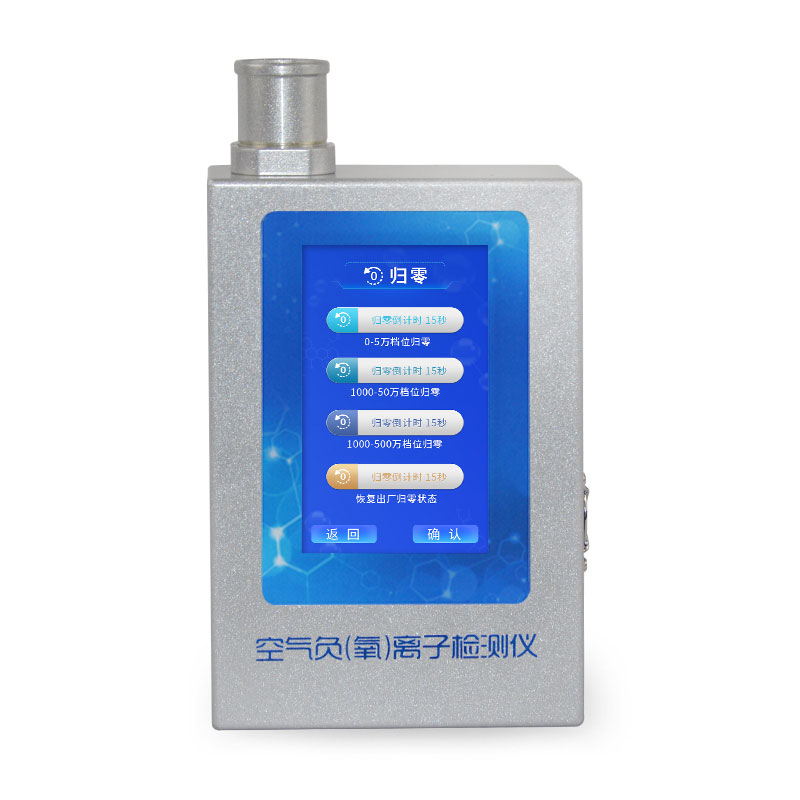Shandong Fengtu IOT Technology Co., Ltd
Sales Manager:Ms. Emily Wang
Cel,Whatsapp,Wechat:+86 15898932201
Email:info@fengtutec.com
Add:No. 155 Optoelectronic Industry Accelerator, Gaoxin District, Weifang, Shandong, China

Sales Manager:Ms. Emily Wang
Cel,Whatsapp,Wechat:+86 15898932201
Email:info@fengtutec.com
Add:No. 155 Optoelectronic Industry Accelerator, Gaoxin District, Weifang, Shandong, China

Model:FT-FY2
Brand:fengtu
Negative ion tester
Features: Mobile measurement | Start measuring | Intuitive reading | Simple operation | Ultra-long standby time
Negative ion tester product introduction:
Negative ion tester is a high-precision, professional air negative ion and formaldehyde detection and analysis instrument. It adopts an advanced cylindrical capacitor structure negative (oxygen) ion capture mechanism to capture negative (oxygen) ions in the atmosphere, and then uses a unique algorithm to perform precise statistical calculations. It has the advantages of stable measurement process, rapid response, and accurate measurement results. At the same time, it has strong resistance to electromagnetic, static electricity, and electromagnetic wave interference, and has excellent sensitivity and capture ability for small-particle negative ions, with excellent overall performance.
The negative ion tester is easy to operate, with a 5.0-inch full-color large screen that displays real-time measurement data, instrument working status, and automatically calculates the average value. Operators can quickly measure without professional training.
Negative ion tester product application:
It can measure the concentration of atmospheric negative oxygen ions and formaldehyde in the air in real time. It is an optimal tool for measuring and demonstrating the concentration of negative ions in environmental monitoring, nano-coatings, negative ion health products, negative ion home improvement building materials, indoor testing, air treatment, air purifiers and their products.
Negative ion tester working principle:
The principle of "capacitive inhalation method" is used to detect negative ions and measure the concentration of negative ions in the air. A certain amount of polarization voltage is loaded on the polarization plate (or bias plate) of the ion sensor (or collection barrel, collection tube), and the air to be measured passes through the sensor at a set speed. Specific small-particle negative ions in the air are deflected under the action of the electric field and captured by the collection plate. The negative charge of the collected negative ions is processed by the collector to calculate the charge concentration of the negative ions.
Negative ion tester advantages and features:
1. Screen display: 5.0-inch capacitive touch screen, 800*480 high resolution, real-time display of negative (oxygen) ion measurement results;
2. Accurate measurement: using the internationally advanced cylindrical capacitive suction method as the measurement method;
3. Small size: compact internal structure, exquisite appearance, can adapt to various environmental detection, convenient for mobile use;
4. Ultra-long standby time: built-in large-capacity lithium battery (12V 3000mAh), not limited by power supply and site, and can be tested immediately after turning on;
5. Sensitive response: data refresh frequency reaches 1 second/time;
6. Simple operation: The instrument is easy to operate and the full-color large font display is clear and concise;
Negative ion tester technical parameters:
Negative ion concentration:
Measurement function: manual measurement, automatic measurement;
Measurement method: Cylindrical capacitor structure negative (oxygen) ion capture mechanism;
Measuring range: 0-50,000, 1000-500,000, 1000-500,000;
Measurement accuracy: ±5%
Resolution: 1 piece/cm3
Mobility: 0.4~1.0 (cm2/V*sec)
Measurement interval: 1 second/time
Measuring mode: continuous
Communication interface: USB
Working environment: Temperature: 0~60℃; Humidity: 0~85%RH
Power supply: DC12V 1A adapter
Built-in battery: battery power supply time ≥ 8 hours
Average power consumption: ≤2W
Dimensions: 200mm*132mm*58mm
Body weight: 1kg
Shell material: metal
Formaldehyde parameters:
Display data unit: ppm and mg/m³;
Range: 0-5ppm;
Resolution: 0.01ppm;
Warm-up time: less than 3 minutes;
Response time: less than 60 seconds;
Recovery time: less than 60 seconds;
Working temperature: -20℃~50℃;
Working humidity: 15%RH~90%RH (no condensation);
Storage temperature: 0℃~25℃;
Service life: 5 years (18℃-25℃ in air)
Mounting bracket: tripod (optional)
Accessories: adapter, cleaning brush, USB data cable, special protective suitcase
As industrialization speeds up and cities expand, air quality has become a growing concern. Traditional fixed - station air quality monitoring offers precise data but has drawbacks like high costs, limited monitoring areas, and inability to collect continuous spatiotemporal data. Mobile air quality...
The six elements in Weather Instruments usually refer to air temperature, humidity, air pressure, wind speed, wind direction, and rainfall amount. The air temperature reflects the degree of hotness or coldness of the air and has a significant impact on agricultural production, human comfort, etc. Hu...
In modern society, the measurement of visibility is of great significance. In terms of meteorological research, visibility data is a crucial element for analyzing atmospheric characteristics. Its value can reflect the conditions of water vapor and particulate matter in the atmosphere, helping meteor...
Meteorological monitoring is closely intertwined with our daily lives. From daily commuting to agricultural production, from industrial operations to urban planning, meteorological information plays a pivotal role. Precise meteorological monitoring enables early warnings of severe weather events suc...